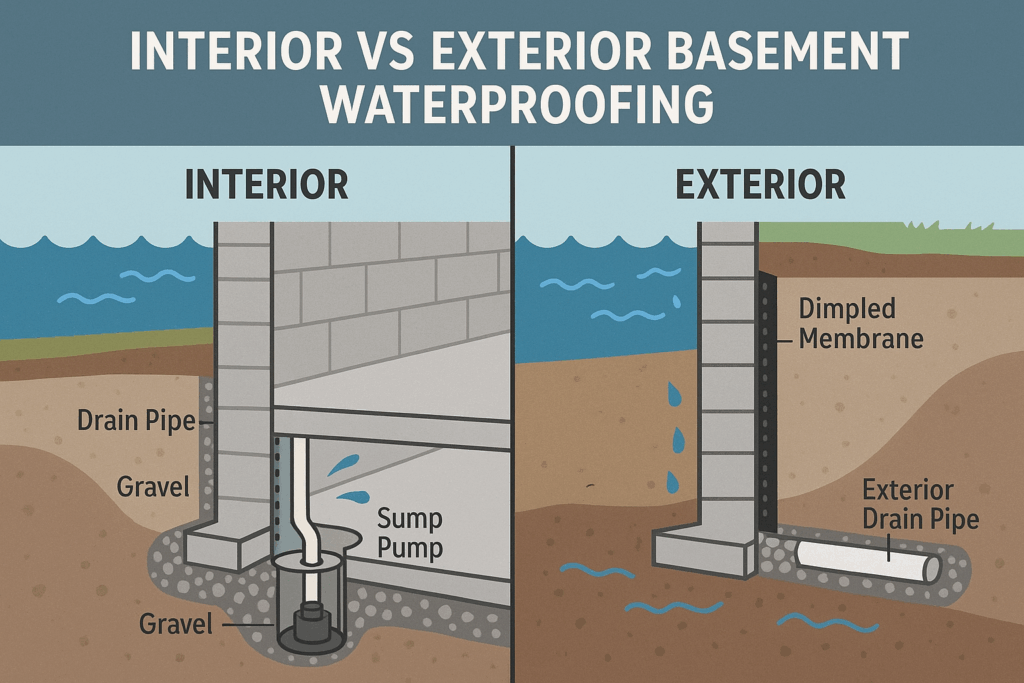Navigating the world of home maintenance can feel overwhelming, especially when it comes to something as crucial as keeping your basement dry. If you’ve ever dealt with a damp, musty, or even overtly leaky basement, you know the headache it can cause. The good news is, there are effective solutions: interior and exterior basement waterproofing. But which one is the right fit for your home?
Let’s break down these two primary approaches to help you make an informed decision, all while keeping things friendly and focused!
Understanding the Problem: Why Basements Get Wet
Before diving into solutions, it’s helpful to know why basements leak. The most common culprit is hydrostatic pressure. When rain or groundwater saturates the soil around your foundation, it presses against the basement walls. If there are any cracks, porous spots, or weaknesses in the foundation, water will find its way in.
Other common causes include:
- Poor Drainage: Gutters overflowing or downspouts directing water too close to the foundation.
- Foundation Cracks: From minor hairline fissures to more significant structural cracks.
- Failed or Clogged Drain Tiles: Old or poorly installed exterior drainage systems.
- High Water Table: When the natural water level in the ground is high.
Interior Basement Waterproofing:
Interior waterproofing focuses on managing water once it has entered the basement, rather than preventing its entry.
How it Works:
- Perimeter Channel System: A trench is dug around the inside perimeter of the basement floor.
- Drainage System: A perforated pipe is laid to collect water seeping through walls or from under the floor.
- Sump Pump Installation: Water is directed to a sump pump and pumped out of the home.
- Wall Vapor Barrier (Optional): A waterproof membrane may be installed to direct water into the drainage system.
- Concrete Repair: The trench is covered with concrete to integrate it into the basement floor.
Pros of Interior Waterproofing:
- Less invasive with no exterior excavation.
- More affordable.
- Faster installation.
- Effective for managing existing leaks.
- Can be done year-round.
Cons of Interior Waterproofing:
- Doesn’t stop water from entering the walls.
- Loss of a small amount of usable space along the perimeter.
- Relies on a sump pump which needs maintenance and backup power.
Exterior Basement Waterproofing:
Imagine stopping the water before it even reaches your foundation walls. That’s the essence of exterior waterproofing.
How it Works:
This method involves excavating the soil around the exterior of your foundation, exposing the basement walls. Once exposed, several steps are typically taken:
- Cleaning and Repairing Walls: Any cracks are sealed, and the walls are cleaned thoroughly.
- Waterproof Membrane/Coating: A waterproof coating or membrane (often a thick, rubberized material) is applied directly to the exterior of the foundation walls.
- Drainage System (French Drain): A perforated pipe is installed at the base of the foundation, surrounded by gravel, to collect and redirect groundwater.
- Backfilling: The excavated area is backfilled, often with gravel for improved drainage.
Pros of Exterior Waterproofing:
- Stops water at the source.
- Protects the foundation.
- Reduces hydrostatic pressure.
Cons of Exterior Waterproofing:
- Not Permanent
- Invasive and disruptive.
- Costly.
- Weather dependent.
- Not always possible in tight or obstructed spaces.
So, Which is Right for Your Home?
The best choice depends on your specific situation, the severity of the problem, your budget, and your long-term goals for your basement.
Consider Exterior Waterproofing if:
- You are building a new home.
- You’re doing major exterior renovations that involve excavation.
- You want a comprehensive, long-term solution.
- You’re facing serious structural issues due to water saturation.
Consider Interior Waterproofing if:
- Your basement has occasional leaks or dampness.
- You need a budget-friendly solution.
- Exterior excavation isn’t possible.
- You want to manage existing water and protect finished spaces.
- You plan to finish your basement and need a dry space.
The Verdict: Consult a Professional!
Ultimately, the most helpful advice is to consult with a reputable basement waterproofing specialist. They can assess your unique situation, identify the source of your water issues, and recommend the most effective and appropriate solution for your home and budget. They can also explain any local building codes or specific considerations for your area.
A dry basement is a happy basement – and a valuable part of your home. By understanding the differences between interior and exterior waterproofing, you’re well on your way to achieving that peace of mind!

